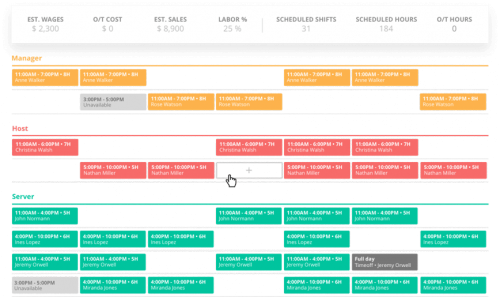How To Calculate Employee Work Hours Step by Step
Want to learn how to calculate work hours? Discover top tips that can help you s...

Few tasks create anxiety among managers and employees like the performance review.
Managers struggle to balance positive feedback with the need for improvement. Employees aren’t sure how to take the feedback and begin to worry about their jobs. All this stress and struggle is avoidable if you, the manager, approach the task in the right way.
But what is “the right way”? The experts at Sling reveal 15 tips for conducting a performance review (be it written or face-to-face) and show you four examples of performance reviews that really work.
A performance review is not an opportunity to unload a long list of criticisms. Rather, it’s an honest evaluation of the employee’s performance, both good and bad. Think of the performance review as a way to:
When you build your performance review around these metrics, it gives your employees the information they need to grow within their position and benefit the business as a whole.

Most performance reviews will be built on six fundamental components:
How you choose to format and grade these components is up to you and the needs of your business. Some businesses use an A, B, C, D, F grading system. Some use scoring of 1 to 5, or 1 to 10. Some use percentages.
Whatever system you settle on, make sure that the performance review is easy to read (if you go with a written form) and communicates the information clearly and concisely.
Whether you compose a written performance review, conduct a face-to-face evaluation, or do both, these 15 tips will help you inspire the best from your employees.
Making the environment in which you hold your performance review as comfortable as possible goes a long way toward putting your employee at ease even before the meeting begins.
Imagine yourself in your employees’ shoes. You walk into a cavernous conference room. The supervisor at the far end of a long table tells you to have a seat at the opposite end. If you would be intimidated, chances are your employee will be intimidated as well.
There’s nothing wrong with using a conference room for a performance review, but sit next to the employee rather than 20 feet away and do what you can to put them at ease.
Holding your performance reviews in a location other than your office is an ideal way to minimize distractions. Even simple interruptions — phone calls, emails, your mobile phone beeping, someone knocking on your door — diminish the effectiveness and poignancy of what you have to say.
If you do decide to hold a performance review in your office (which is a great way to make your employees comfortable), silence your phones, turn off your email, and hang a “Do Not Disturb” sign on your door before the meeting starts.
Many managers wonder where to start when they’re faced with putting together a performance review. Our suggestion: review the job description. Whether it’s for a waiter, a food runner, a customer service rep, or something else entirely, ask yourself these questions as the basis for the rest of your review:
While you’re looking at the job description, make sure it’s up to date. Has the position changed from when the description was written? Have new duties been introduced since the employee was hired? Only when the job description is up to date and accurate will you be able to provide a fair performance review.

Don’t make your performance review an annual event. Instead, provide feedback throughout the year. Many businesses hold performance reviews at the end of major projects. Some set them for every three months.
Choose a frequency that’s right for your business and your employees. And be sure that the performance review isn’t a surprise. Your employees should know when it’s coming.
Don’t let the most recent activity of your employees color your evaluation. A performance review should be based on everything that occurred since the last review, not just the past week or month.
When you look at the big picture — not just the time last month when the employee saved a big project or the time he missed a critical deadline — it can help you be more objective with your feedback.
At its most basic, a performance review should be based on three key points:
The first two competencies may include skills such as organization, company/product knowledge, attitude, and anything else that’s important for the job. If your business hasn’t defined these competencies yet, now is a good time to do so.
For inspiration, look back at the six fundamental skills in the What Should A Performance Review Look Like? section above.
Each of the competencies and key points mentioned above differs in importance. That’s why it’s essential to weigh each aspect of your employees’ performance.
For example, company-specific competencies (like commitment to the organization) should be worth 20 percent. Position-specific competencies (like customer service orientation) should be worth 30 percent. Achievement (ability to reach goals and meet deadlines) should be worth 50 percent.
Not sure how to process all those numbers? Here’s a simple formula.
So if your employee scores 80 percent on company-specific competencies, 90 percent on position-specific competencies, and 95 percent on achievement, the final formula would look like this:
Using that calculation, you can make certain parts of the performance more or less influential on the final score.
A written performance review is useful for more frequent evaluations, but it’s beneficial to hold a face-to-face review at least once per year. You can convey a great deal with your tone of voice and expressions. Those things don’t come across in a letter, no matter how well-written.
The face-to-face performance review also makes it possible to have a discussion about your employee’s work, rather than just a one-sided monologue.

Whether your review is written or in-person, always lead with the positive. This puts the employee in a favorable frame of mind and makes them more amenable to the suggestions for improvement that come later.
Think of your performance review as a sandwich: the positives are the bread and the negatives are the meat, lettuce, and condiments.
As we mentioned, it’s a good idea to lead with the positive to set the right mood for the performance review, but it’s also smart to end on a positive note.
Chances are, the last thing you talk about will be what the employee remembers most. If that last thing is negative, it could affect everything they do when they return to work. End on a positive note — even if the employee has plenty of things to work on — so they feel good about themselves and secure in their job.
Honesty is the best policy, so don’t be afraid to be open with your employees about their performance. Don’t sugar-coat your assessment or beat around the bush. Your employees will know when you’re being overly-flattering, and the review process is hard enough without making your employees decipher what you’re trying to say.

Before presenting your review to an employee, gather feedback from her coworkers. It can also be informative to your analysis if you ask the employee herself how she thinks she’s doing. Peer feedback and self-appraisals can go a long way toward giving you the most complete picture possible of an employee’s performance.
The words you use are just as important as the message you’re trying to communicate. That’s why it’s vital to use the right language during the performance review. Be as clear and specific as possible without sounding trite and insincere.
Avoid general terms like “good,” “great,” and “excellent.” Opt instead for action words like:
These types of words are more descriptive and, therefore, more meaningful.
It’s also a good idea to create a list of strength and weakness phrases for common parts of the performance review, such as:
For example, a strength phrase for performance is:
Mal excels at developing strategies that deliver results.
A weakness phrase for performance is:
Does not take initiative unless prompted.
A strength phrase for attitude is:
Does not let difficult circumstances get her down.
A weakness phrase for attitude is:
Negative attitude in some situations has a tendency to cause problems.
With a list of strength and weakness phrases like these on hand when you conduct a review — be it written or face-to-face — you can be as descriptive as possible. Just be sure to elaborate on the phrases you choose so that the employee has a clear idea of what you mean.
Reviewing old goals and setting new goals is a crucial component of every successful performance review.
When you set goals for your employees, you give them something to work toward. You give them a way to quantify their performance. They can look at what they’re doing and ask, “Is this habit getting me closer to achieving my goals? What can I do that would make it easier to reach those goals?”
Avoid limiting feedback to formal, scheduled occasions once or twice per year. Offer informal assessments and suggestions throughout the year.
If there’s something an employee needs to work on, be sure to make a note of it in their file so you can refer to it when it comes time for the annual performance review. This will help the employee work on their strengths and weaknesses every day.
And don’t neglect to provide feedback to the high-performing employees as well. Let them know they’re doing a good job so they don’t think they have to change. Even a simple “good job” email or note on their desk goes a long way toward helping them feel like a valuable part of the team.
Here are four examples of performance reviews that really work. We’ve included one good, one satisfactory, one poor, and one combination review.
Kalee exceeds all expectations in her role as server. She always has a positive attitude. She adapts easily to rapid change in the workplace. She works well under pressure by herself and with other team members. She is detail-oriented and completes tasks in a timely manner. She even seeks out additional responsibilities when her schedule allows.
Shep meets all company expectations in his role as customer service rep. He adapts well to client demands and changing workloads. He maintains a sense of detail and a positive attitude even under pressure. These skills, though, come at the expense of time management. And while Shep shows an aptitude for leadership, he doesn’t actively seek out leadership training or opportunities.
At times, Jane can be very effective at her job as shift manager when she is engaged in her work. Unfortunately, Jane is frequently late, and this seriously impacts the productive hours of her workday. During the next quarter, we would like Jane to focus on attendance—being clocked in and ready to work at the start of her shift.
River meets some of the company expectations in her role as barista but falls well short of others. She is an active listener, manages her time efficiently, and is always conscientious about the quality of her work. River needs to work on demonstrating professionalism at all times and, though she works well by herself, would benefit greatly from additional team-building skills.
The 15 tips on this list will certainly make your job easier when performance-review time rolls around. But to simplify your responsibilities every day, you need a scheduling solution like Sling. Sling puts you in complete control of your employees’ work schedule with powerful features like:

Each of these features is designed to streamline the scheduling process and keep everything, and everyone, organized and running smoothly. And if the time you can save isn’t enough, Sling also saves you money. Sling can be used as a free tool for up to 50 users, or as a full suite of tools with a Premium or Business subscription.
Visit GetSling.com today to open an account and see why our customers give us a 5 out of 5 performance review every time.
See Here For Last Updated Dates: Link
This content is for informational purposes and is not intended as legal, tax, HR, or any other professional advice. Please contact an attorney or other professional for specific advice.
Schedule faster, communicate better, get things done.